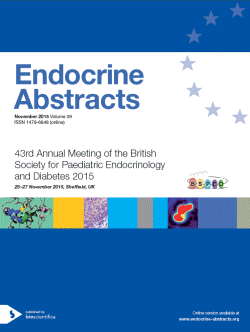
Society for Endocrinology BES 2015
Edinburgh,
UK
02 Nov 2015 - 04 Nov 2015

Oral Communications
Early Career Oral Communications
ea0038oc1.1 | Early Career Oral Communications | SFEBES2015
A novel pharmacological approach to target LH and testosterone hypersecretion in women with polycystic ovary syndrome: a randomised, double-blind, placebo-controlled multi-centre randomised clinical trial of the neurokinin B receptor antagonist AZD4901
George Jyothis , Kakkar Rahul , Marshall Jayne , Scott Martin , Finkelman Richard , Ho Tony , McIntosh Stuart , Veldhuis Johannes , Skorupskaite Karolina , Anderson Richard , Webber Lorraine
ea0038oc1.2 | Early Career Oral Communications | SFEBES2015
Mutations in IGSF10 cause self-limited delayed puberty, via disturbance of GnRH neuronal migration
Howard Sasha , Guasti Leo , Ruiz-Babot Gerard , Mancini Alessandra , David Alessia , Storr Helen , Metherell Louise , Sternberg Michael , Cabrera Claudia , Warren Helen , Barnes Michael , Wehkalampi Karoliina , Andre Valentina , Gothilf Yoav , Cariboni Anna , Dunkel Leo
ea0038oc1.3 | Early Career Oral Communications | SFEBES2015
RNA-sequencing of mouse adrenals reveals the pathways perturbed by loss of nicotinamide nucleotide transhydrogenase
Meimaridou Eirini , Goldsworthy Michelle , Chortis Vasileios , Foster Paul , Arlt Wiebke , Cox Roger , Metherell Lou
ea0038oc1.4 | Early Career Oral Communications | SFEBES2015
Adipose tissue-specific androgen generation fuels an adverse metabolic phenotype in patients with polycystic ovary syndrome
O'Reilly Michael , Kempegowda Punith , Gathercole Laura , Bujalska Iwona , Taylor Angela , Hughes Beverley , Dunn Warwick , Semple Robert , Tomlinson Jeremy , Arlt Wiebke
ea0038oc1.5 | Early Career Oral Communications | SFEBES2015
Interaction of the MR and GR in the nucleus and at DNA
Pooley John R , Presman Diego M , Davis Luke , Ganesan Sundar , Muratcioglu Serena , Keskin Ozlem , Schiltz Louis , Levi Valeria , Lightman Stafford L , Hager Gordon L
ea0038oc1.6 | Early Career Oral Communications | SFEBES2015
Urine steroid metabolomics as a diagnostic tool in primary aldosteronism
Lang Katharina , Beuschlein Felix , Biehl Michael , Dietz Anna , Riester Anna , Hughes Beverly A , O'Neil Donna M , Hahner Stefanie , Quinkler Marcus , Lenders Jacques W , Shackleton Cedric H L , Reincke Martin , Arlt Wiebke



